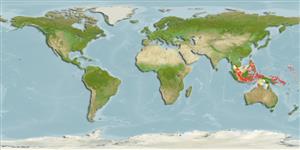Classification / Names
आम नाम | उपशब्द | Catalog of Fishes(वर्ग, प्रजाति) | ITIS | CoL | WoRMS | Cloffa
>
Gobiiformes (Gobies) >
Gobiidae (Gobies) > Gobiinae
Etymology: Trimma: Greek, trimma, -atos = something crushed (Ref. 45335); erdmanni: Named for Mark V. Erdmann, Conservation International’s Indonesian Marine Program..
More on author: Winterbottom.
Environment: milieu / climate zone / depth range / distribution range
पारिस्थितिकी
समुद्री ड़िमरसल; गहराई सीमा 12 - 66 m (Ref. 90102). Tropical
Western Pacific Ocean: Indonesia, Papua New Guinea and the Philippines.
आकार / वज़न / Age
Maturity: Lm ? range ? - ? cm
Max length : 2.6 cm SL पुल्लिंग / अलिंग; (Ref. 87358)
Short description
आकृति विज्ञान | मौरफोमैटरिक्स
पृष्ठीय रीढ़ (सम्पूर्ण): 7; पृष्ठीय सौफट रेज़ (सम्पूर्ण): 9; गुदा कांटा 1; ऐनल सौफट रेज़: 8. This species is distinguished from its congeners by having the following characters: a reddish-orange body with a darker red to orange lateral stripe with darker borders on the body which extends anteriorly onto the head, where it bifurcates, and there is a thin longitudinal light stripe below the eye; usually lacks scales in the predorsal midline but when present, are separated from the first dorsal fin by an unscaled area; the second spine of the first dorsal is elongated; dorsal rays 9; anal rays 8; a single branch in the fifth pelvic fin ray; gill rakers on the first gill arch 19-22 (Ref. 87358); characterized further by having longitudinal scale series 23-24; cheek or opercle without scales; depth of body 3.8-4.2 in SL (Ref. 90102).
Inhabits coral reefs, often outer slopes on isolated rock or coral outcrops in 12-66 m (Ref. 90102).
Life cycle and mating behavior
परिपक्व अवधि | पुनरुत्पत्ति | मछलीऔ का अंडे देना | अंडे | Fecundity | लार्वा
Winterbottom, R., 2011. Six new species of the genus Trimma (Percomorpha; Gobiidae) from the Raja Ampat Islands, Indonesia, with notes on cephalic sensory papillae nomenclature. aqua, Int. J. Ichthyol. 17(3):127-162. (Ref. 87358)
IUCN Red List Status (Ref. 130435)
Threat to humans
Harmless
Human uses
अधिक जानकारी
आम नामउपशब्दचपायचयपरभक्षीईकोटोकसीकोलौजीपुनरुत्पत्तिपरिपक्व अवधिमछलीऔ का अंडे देनाSpawning aggregationFecundityअंडेEgg development
Age/Sizeबाढ़Length-weightLength-lengthLength-frequenciesमौरफोमैटरिक्सआकृति विज्ञानलार्वालारवल गतिकीभर्तीबहुतायतBRUVS
संदर्भजलीयकृषिजलीयकृषि रूपरेखाखींचआनुवंशिकीElectrophoresesहैरेटिबिलटीबीमारीप्रक्रमणNutrientsMass conversion
सहयोगीयोतस्वीरेStamps, Coins Misc.ध्वनिसिगुयटिरारफ्तारतैरने के प्रकारगिल क्षेत्रOtolithsदिमागदृष्टि
साधन
Special reports
Download XML
इंटरनेट स्रोत
Estimates based on models
Preferred temperature (Ref.
123201): 28 - 29.2, mean 28.7 °C (based on 78 cells).
Phylogenetic diversity index (Ref.
82804): PD
50 = 0.5000 [Uniqueness, from 0.5 = low to 2.0 = high].
Bayesian length-weight: a=0.01023 (0.00477 - 0.02194), b=3.02 (2.84 - 3.20), in cm total length, based on LWR estimates for this (Sub)family-body shape (Ref.
93245).
Fishing Vulnerability (Ref.
59153): Low vulnerability (10 of 100).
